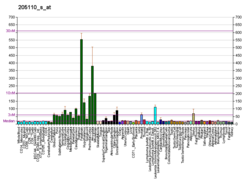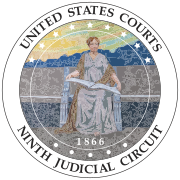호모사피엔스 종의 단백질 코딩 유전자
섬유질 성장인자 13 은 인간에게 FGF13 유전자 에 의해 암호화 된 단백질이다.[5] [6]
이 유전자가 인코딩한 단백질은 섬유질 성장인자 (FGF) 계열의 일원이다. FGF 가족 구성원은 광범위한 유사성 및 세포 생존 활동을 가지고 있으며 배아 발달 , 세포 성장 , 형태생성 , 조직 수리 , 종양 성장, 침공 등 다양 한 생물학적 과정 에 관여하고 있다. 이 유전자는 신드롬 X와 연관 된 지적 장애인 Börjeson-Forssman-Lehmann 증후군 (BFLS)과 연관된 부위에 위치하는데, 이것은 BFL 증후군의 가족적인 경우 유전자가 될 수 있음을 암시한다. 이 유전자의 기능은 아직 결정되지 않았다. 다른 ISO 양식을 인코딩하는 두 개의 다른 분할된 대본이 이 유전자에 대해 설명되었다.[6]
참조 ^ a b c GRCh38: 앙상블 릴리스 89: ENSG00000129682 - 앙상블 , 2017년 5월^ a b c GRCm38: 앙상블 릴리스 89: ENSMUSG000031137 - 앙상블 , 2017년 5월^ "Human PubMed Reference:" . National Center for Biotechnology Information, U.S. National Library of Medicine .^ "Mouse PubMed Reference:" . National Center for Biotechnology Information, U.S. National Library of Medicine .^ Smallwood PM, Munoz-Sanjuan I, Tong P, Macke JP, Hendry SH, Gilbert DJ, Copeland NG, Jenkins NA, Nathans J (Oct 1996). "Fibroblast growth factor (FGF) homologous factors: new members of the FGF family implicated in nervous system development" . Proc Natl Acad Sci U S A . 93 (18): 9850–7. Bibcode :1996PNAS...93.9850S . doi :10.1073/pnas.93.18.9850 PMC 38518 PMID 8790420 . ^ a b "Entrez Gene: FGF13 fibroblast growth factor 13" . 추가 읽기 Gerhard DS, Wagner L, Feingold EA, et al. (2004). "The status, quality, and expansion of the NIH full-length cDNA project: the Mammalian Gene Collection (MGC)" . Genome Res . 14 (10B): 2121–7. doi :10.1101/gr.2596504 . PMC 528928 PMID 15489334 . Wittmack EK, Rush AM, Craner MJ, et al. (2005). "Fibroblast growth factor homologous factor 2B: association with Nav1.6 and selective colocalization at nodes of Ranvier of dorsal root axons" . J. Neurosci . 24 (30): 6765–75. doi :10.1523/JNEUROSCI.1628-04.2004 PMC 6729706 PMID 15282281 . Popovici C, Conchonaud F, Birnbaum D, Roubin R (2004). "Functional phylogeny relates LET-756 to fibroblast growth factor 9" . J. Biol. Chem . 279 (38): 40146–52. doi :10.1074/jbc.M405795200 PMID 15199049 . Facchiano A, Russo K, Facchiano AM, et al. (2003). "Identification of a novel domain of fibroblast growth factor 2 controlling its angiogenic properties" . J. Biol. Chem . 278 (10): 8751–60. doi :10.1074/jbc.M209936200 PMID 12496262 . Strausberg RL, Feingold EA, Grouse LH, et al. (2003). "Generation and initial analysis of more than 15,000 full-length human and mouse cDNA sequences" . Proc. Natl. Acad. Sci. U.S.A . 99 (26): 16899–903. doi :10.1073/pnas.242603899 PMC 139241 PMID 12477932 . Schoorlemmer J, Goldfarb M (2003). "Fibroblast growth factor homologous factors and the islet brain-2 scaffold protein regulate activation of a stress-activated protein kinase" . J. Biol. Chem . 277 (51): 49111–9. doi :10.1074/jbc.M205520200 PMC 4266389 PMID 12244047 . Knox S, Merry C, Stringer S, et al. (2002). "Not all perlecans are created equal: interactions with fibroblast growth factor (FGF) 2 and FGF receptors" . J. Biol. Chem . 277 (17): 14657–65. doi :10.1074/jbc.M111826200 PMID 11847221 . Munoz-Sanjuan I, Smallwood PM, Nathans J (2000). "Isoform diversity among fibroblast growth factor homologous factors is generated by alternative promoter usage and differential splicing" . J. Biol. Chem . 275 (4): 2589–97. doi :10.1074/jbc.275.4.2589 PMID 10644718 . Gecz J, Baker E, Donnelly A, et al. (1999). "Fibroblast growth factor homologous factor 2 (FHF2): gene structure, expression and mapping to the Börjeson-Forssman-Lehmann syndrome region in Xq26 delineated by a duplication breakpoint in a BFLS-like patient". Hum. Genet . 104 (1): 56–63. doi :10.1007/s004390050910 . PMID 10071193 . S2CID 29716695 . Yao DL, Masonic K, Petullo D, et al. (1999). "Pretreatment with intravenous FGF-13 reduces infarct volume and ameliorates neurological deficits following focal cerebral ischemia in rats". Brain Res . 818 (1): 140–6. doi :10.1016/S0006-8993(98)01118-4 . PMID 9914447 . S2CID 23714326 . Greene JM, Li YL, Yourey PA, et al. (1998). "Identification and characterization of a novel member of the fibroblast growth factor family". Eur. J. Neurosci . 10 (5): 1911–25. doi :10.1046/j.1460-9568.1998.00211.x . PMID 9751161 . S2CID 26104531 .
안지오포에틴 CNTF EGF(ErbB)
Fgf.
FGFR1 FGFR2 고민자: 어소페르민 FGF (1 , 2(BFGF), 3 , 4 , 5 , 6 , 7 (KGF ), 8 , 9 , 10(KGF2), 17 , 18 , 22 )팔리퍼민 리피퍼민 셀퍼카티닙 스피리페르민 트라페르민 FGFR3 FGFR4 정렬되지 않음
HGF(c-Met) 인터넷 거버넌스 포럼
LNGF (p75NTR ) PDGF RET(GFL)
SCF(c-Kit) TGFβ 트르크
트르카 TrkB 고민자: 3,7-DHF 3,7,8,2'-THF 4'-DMA-7,8-DHF 7,3'-DHF 7,8-DHF 7,8,2'-THF 7,8,3'-THF 아미트립티라인 BDNF BNN-20 디옥시게두닌 디프레닐 디오스메틴 DMAQ-B1 HIOC LM22A-4 N-아세틸세로토닌 NT-3 NT-4 노르웨고닌 (5,7,8-THF) R7 R13 TDP6 TrkC
VEGF 다른이들 추가 성장 요인: 아드레노메둘린 군집 자극 요인 (대신 여기 를 참조하십시오) 결합조직성장인자(CTGF) 에프린 (A1 , A2 , A3 , A4 , A5 , B1 , B2 , B3 )Erythropoietin (대신 여기 를 참조하십시오)포도당-6-인산 이소메라아제(GPI; PGI, PHI, AMF) 글리아 성숙 계수(GMF) 간종유래성장인자(HDGF) 인터루킨 /T-세포 성장 요인 (대신 여기 참조)백혈병 억제 인자(LIF) 대식세포 자극 단백질(MSP; HLP, HGFLP) 미드킨(NEGF2) 마이그레이션 자극 계수(MSF; PRG4) 온코모둘린 뇌하수체 아데닐레이트 사이클라아제 활성화 펩타이드(PACAP) 플레오트로핀 레날라아제 트롬보포에틴 (대신 여기 를 참조)Wnt 신호 단백질 추가 성장 계수 수용체 조절기: 세레브롤리신 (네로트로핀 혼합물)







